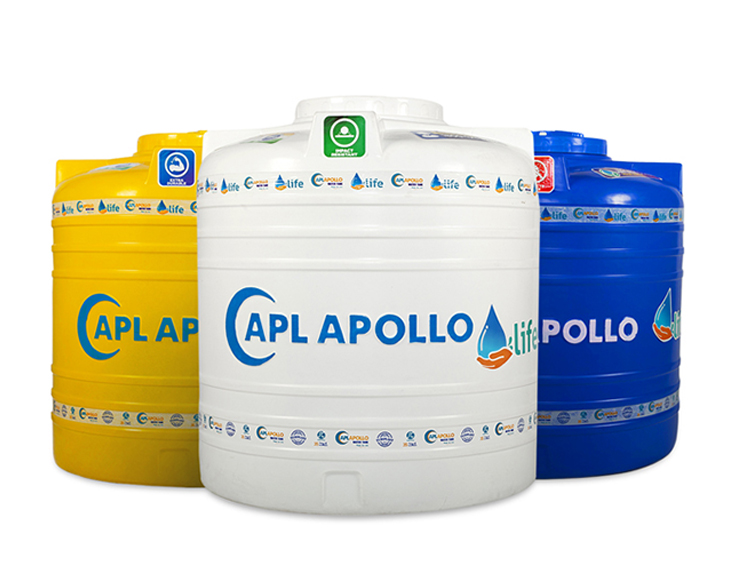Water storage is a very crucial requirement for various applications, from residential, industrial, and agricultural needs. When it comes to selecting the appropriate type of water tank, two common choices are plastic and concrete. Plastic water tanks have gained increasing popularity in recent years due to their numerous benefits over traditional concrete water tanks.
In this article, we will discuss the primary advantages of plastic water tanks and why they are becoming the preferred choice over concrete water tanks.
LIGHTWEIGHT AND EASY TO INSTALL
One of the most notable advantages of plastic water tanks lies in their is that they are lightweight. In comparison to heavy concrete tanks that demand robust machinery for installation, plastic tanks are rather easier to transport and set up. This reduces the installation expenses and a faster setup process, making plastic tanks a more logical option for both residential and commercial purposes.
COST-EFFICIENT
While considering the cost aspect, plastic water tanks have a clear advantage over their concrete counterparts. They tend to be more budget-friendly both in terms of the initial purchase price and long-term maintenance expenses. The production process of plastic tanks requires less labor and the raw materials are typically more affordable. Furthermore, their easy installation, as mentioned earlier, leads to additional cost savings.
DIVERSE RANGE OF SIZES AND SHAPES
Plastic water tanks offer a broad spectrum of size and shape options, catering to various applications and spatial constraints. Whether you require a small tank for a residential property or a large one for industrial purposes, there's likely a plastic tank that fits your needs. Furthermore, their flexibility in design allows for customization to accommodate unique spaces and specifications.
LONGEVITY
Generally, we have seen that concrete water tanks are associated with strength but plastic water tanks are also remarkably robust and boast a lengthy service life. High-quality plastic tanks are engineered to endure harsh weather conditions, including prolonged exposure to UV rays, without showing signs of wear. They also stand up well against corrosion and rust, common concerns with concrete tanks over time. Thus, plastic tanks offer extended longevity, reducing the need for frequent replacements or repairs.
RESILIENCE AGAINST CRACKS AND LEAKS
Concrete water tanks are susceptible to developing cracks and leaks over time, especially if they aren't constructed or maintained properly. But plastic water tanks are seamlessly constructed, significantly reducing the risk of cracks or leaks. This not only safeguards the purity of the stored water but also prevents potential contamination from external sources.
INSULATION AND TEMPERATURE REGULATION
Plastic water tanks excel in insulation properties compared to concrete tanks. They excel at maintaining the water's temperature, preventing freezing in colder climates and overheating in hot regions. This insulation can be valuable in agricultural and industrial scenarios where precise water quality and temperature control are vital.
EASY TO MAINTAIN
Maintaining plastic water tanks is relatively uncomplicated as compared to concrete water tanks. They do not require the same level of upkeep as concrete tanks, which might necessitate periodic sealing to prevent leaks. Cleaning plastic tanks is also easier due to their smooth surfaces, reducing the risk of algae or bacterial growth inside the tank.
PORTABILITY AND RELOCATION
Plastic water tanks are portable and can be relocated as per the need. This adaptability proves advantageous for temporary or mobile water storage needs, such as construction sites or emergency relief operations. Thus, concrete tanks are permanent fixtures and cannot be readily moved.
LOW ENVIRONMENTAL IMPACT
Plastic water tanks have a lower environmental impact compared to concrete tanks. The production of concrete involves significant energy consumption and carbon emissions. Plastic tanks are often crafted from recycled materials and may be recycled at the end of their lifespan, contributing to reduced waste and environmental preservation.
TAILORED CUSTOMIZATION AND EXPANSION
Plastic water tanks can be effortlessly customized to incorporate various features like multiple compartments and overflow systems. This flexibility enables tailored solutions for specific water storage requirements. In addition, if future expansion becomes necessary, plastic tanks can be extended or interconnected more easily compared to concrete tanks.
APL APOLLO’S PLASTIC WATER TANKS
 If you are in search of exceptional quality and reliable water storage solutions, consider APL Apollo water storage tanks. Whether you need them for household or industrial purposes, these tanks are built with precision and rigorous quality control. They are available in 3, 4, and 5 layers, each designed to excel in specific applications.
If you are in search of exceptional quality and reliable water storage solutions, consider APL Apollo water storage tanks. Whether you need them for household or industrial purposes, these tanks are built with precision and rigorous quality control. They are available in 3, 4, and 5 layers, each designed to excel in specific applications.
APL Apollo water tanks offer a range of benefits. These tanks are manufactured entirely from UV-stabilized materials, enhancing their resilience against the harmful effects of sunlight. These water tanks are designed to withstand unexpected impacts and knocks without compromising their functionality. These tanks are easy to set up due to their user-friendly design, saving your time and effort. These water tanks are built with high-quality materials, These tanks are exceptionally durable and resistant to damage, ensuring their longevity and continued use. APL Apollo water tanks are made from food-grade materials, guaranteeing that the stored water remains clean, pure, and safe for human consumption.



